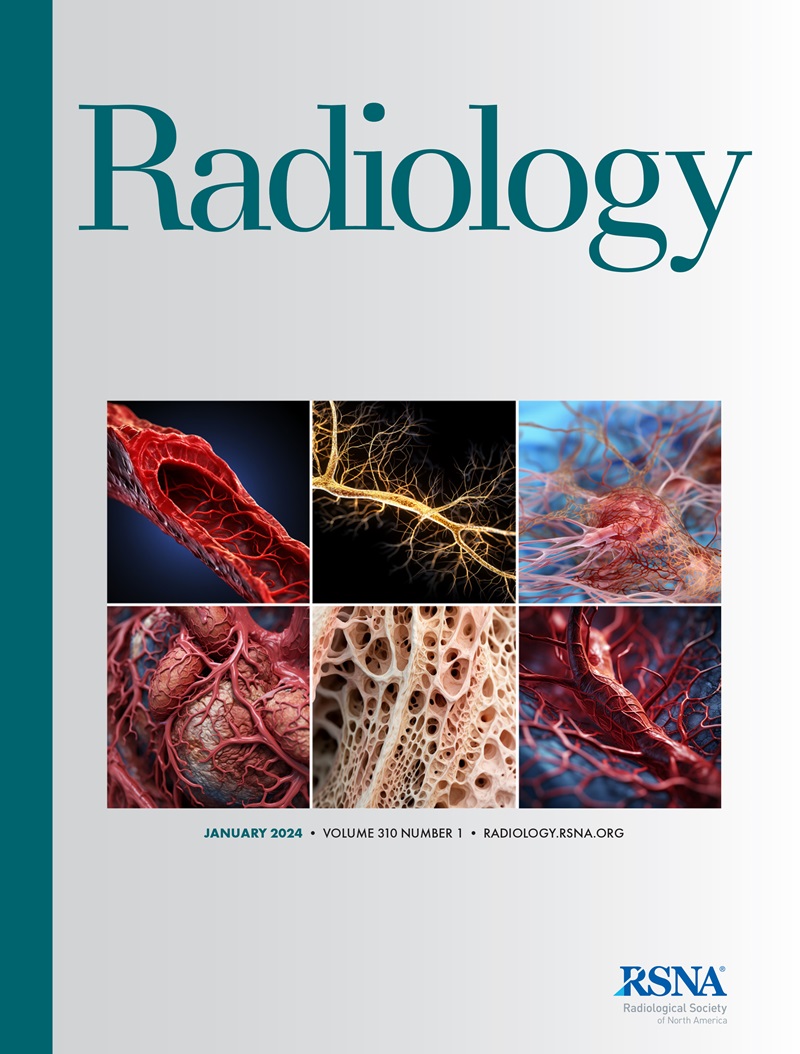Wenya Li, Jing Lv, Honghui Li, Liwen Song, Rui Zhang, Xingyang Zhao, Feichao Xuan, Tong Sun, Kai Long, Yinghua Zhao, Liming Nie
求助PDF
{"title":"Quantification of Vascular Remodeling and Sinusoidal Capillarization to Assess Liver Fibrosis with Photoacoustic Imaging.","authors":"Wenya Li, Jing Lv, Honghui Li, Liwen Song, Rui Zhang, Xingyang Zhao, Feichao Xuan, Tong Sun, Kai Long, Yinghua Zhao, Liming Nie","doi":"10.1148/radiol.241275","DOIUrl":null,"url":null,"abstract":"<p><p>Background Photoacoustic microscopy (PAM) can be used to detect strong absorption from endogenous and exogenous contrast material, making it promising for detailed structural and functional imaging of hepatic sinusoids, including dynamic visualization of permeability. Purpose To evaluate whether PAM-based quantitative parameters of liver function and integrity (lacunarity, blood oxygen saturation [Sao<sub>2</sub>], and Evans blue [EB] permeability) are associated with histopathologic indexes of fibrosis in a mouse model. Materials and Methods Between October 2022 and July 2023, a total of 35 male C57BL/6 mice were included in this study and received intraperitoneal injection of carbon tetrachloride to establish mouse models of progressive liver fibrosis, with seven mice in each group. PAM was performed to visualize vascular structure, Sao<sub>2</sub> distribution, and EB penetration within the hepatic lobule. Histologic findings were used as the reference standard. Associations between the PAM parameters and the pathologic results were evaluated with Spearman rank correlation. Results Mean lacunarity, a PAM parameter, gradually increased with liver fibrosis stage (control: 0.018 arbitrary units [au] ± 0.004 [SD]; fibrosis: 1 week, 0.024 au ± 0.002; 2 weeks, 0.028 au ± 0.003; 4 weeks, 0.034 au ± 0.002; 10 weeks, 0.040 au ± 0.005; <i>P</i> < .001) and was positively correlated with collagen-positive area (Spearman <i>r</i> = 0.88-0.90; <i>P</i> < .001). PAM revealed that Sao<sub>2</sub> decreased with disease progression (control, 0.921 au ± 0.017; 1 week, 0.875 au ± 0.019; 2 weeks, 0.846 au ± 0.020; 4 weeks, 0.802 au ± 0.025; 10 weeks, 0.732 au ± 0.036; <i>P</i> < .001) and was inversely related to hypoxia-inducible factor 1α expression (Spearman <i>r</i> = -0.83; <i>P</i> < .001). EB permeability, indicative of hepatic sinusoid capillarization, was reduced at advanced stages of fibrosis (control: 11.6% [IQR, 11.2%-11.8%]; fibrosis: 1 week, 24.8% [IQR, 23.3%-25.8%]; 2 weeks, 18.4% [IQR, 18.4%-20.0%]; 4 weeks, 5.1% [IQR, 4.9%-6.2%]; 10 weeks, 3.7% [IQR, 3.4%-4.5%]; <i>P</i> < .001). Conclusion PAM-based structural and functional parameters were associated with liver fibrosis severity, and PAM imaging of EB dynamics helped detect sinusoidal capillarization. © RSNA, 2025 <i>Supplemental material is available for this article.</i> See also the editorial by Li and Yao in this issue.</p>","PeriodicalId":20896,"journal":{"name":"Radiology","volume":"314 1","pages":"e241275"},"PeriodicalIF":12.1000,"publicationDate":"2025-01-01","publicationTypes":"Journal Article","fieldsOfStudy":null,"isOpenAccess":false,"openAccessPdf":"","citationCount":"0","resultStr":null,"platform":"Semanticscholar","paperid":null,"PeriodicalName":"Radiology","FirstCategoryId":"3","ListUrlMain":"https://doi.org/10.1148/radiol.241275","RegionNum":1,"RegionCategory":"医学","ArticlePicture":[],"TitleCN":null,"AbstractTextCN":null,"PMCID":null,"EPubDate":"","PubModel":"","JCR":"Q1","JCRName":"RADIOLOGY, NUCLEAR MEDICINE & MEDICAL IMAGING","Score":null,"Total":0}
引用次数: 0
引用
批量引用
Abstract
Background Photoacoustic microscopy (PAM) can be used to detect strong absorption from endogenous and exogenous contrast material, making it promising for detailed structural and functional imaging of hepatic sinusoids, including dynamic visualization of permeability. Purpose To evaluate whether PAM-based quantitative parameters of liver function and integrity (lacunarity, blood oxygen saturation [Sao2 ], and Evans blue [EB] permeability) are associated with histopathologic indexes of fibrosis in a mouse model. Materials and Methods Between October 2022 and July 2023, a total of 35 male C57BL/6 mice were included in this study and received intraperitoneal injection of carbon tetrachloride to establish mouse models of progressive liver fibrosis, with seven mice in each group. PAM was performed to visualize vascular structure, Sao2 distribution, and EB penetration within the hepatic lobule. Histologic findings were used as the reference standard. Associations between the PAM parameters and the pathologic results were evaluated with Spearman rank correlation. Results Mean lacunarity, a PAM parameter, gradually increased with liver fibrosis stage (control: 0.018 arbitrary units [au] ± 0.004 [SD]; fibrosis: 1 week, 0.024 au ± 0.002; 2 weeks, 0.028 au ± 0.003; 4 weeks, 0.034 au ± 0.002; 10 weeks, 0.040 au ± 0.005; P < .001) and was positively correlated with collagen-positive area (Spearman r = 0.88-0.90; P < .001). PAM revealed that Sao2 decreased with disease progression (control, 0.921 au ± 0.017; 1 week, 0.875 au ± 0.019; 2 weeks, 0.846 au ± 0.020; 4 weeks, 0.802 au ± 0.025; 10 weeks, 0.732 au ± 0.036; P < .001) and was inversely related to hypoxia-inducible factor 1α expression (Spearman r = -0.83; P < .001). EB permeability, indicative of hepatic sinusoid capillarization, was reduced at advanced stages of fibrosis (control: 11.6% [IQR, 11.2%-11.8%]; fibrosis: 1 week, 24.8% [IQR, 23.3%-25.8%]; 2 weeks, 18.4% [IQR, 18.4%-20.0%]; 4 weeks, 5.1% [IQR, 4.9%-6.2%]; 10 weeks, 3.7% [IQR, 3.4%-4.5%]; P < .001). Conclusion PAM-based structural and functional parameters were associated with liver fibrosis severity, and PAM imaging of EB dynamics helped detect sinusoidal capillarization. © RSNA, 2025 Supplemental material is available for this article. See also the editorial by Li and Yao in this issue.

 求助内容:
求助内容: 应助结果提醒方式:
应助结果提醒方式:


